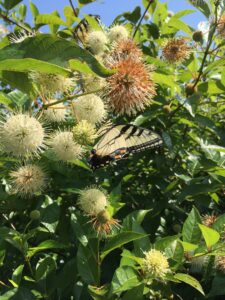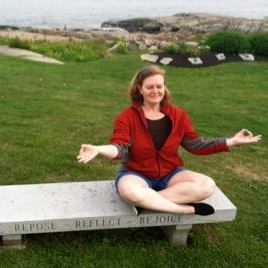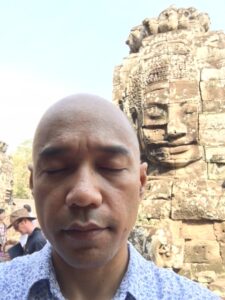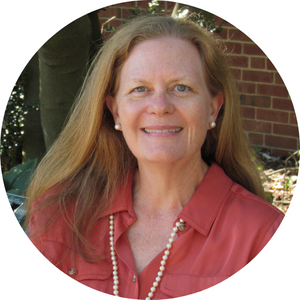By Mary O’Shan Overton, Pittsburgh Theological Seminary
In her acceptance speech at the 1996 National Book Foundation Medal ceremony, the novelist Toni Morrison said that “There is a certain kind of peace that is not merely an absence of war. It is larger than that. […] The peace I am thinking of is the dance of an open mind when it engages another equally open one—an activity that occurs most naturally, most often in the reading/writing world we live in.” I am interested in making space for that kind of peace. In fact, as a writing center director, I feel an ardent responsibility to do so.
 In a time when all of us—students, teachers, tutors, administrators, and others—find ourselves closing our minds because we are besieged by the news and noise from wider society, we need this greater peace. Confronted with voter suppression and book banning; doubts about the longevity of our institutions, including higher education; collapsing infrastructure; the perpetual sounds of traffic, televisions, and violence; wildfires and flooding and weird weather patterns; the coronavirus pandemic and opioid deaths; the wildly fluctuating economy; and the unfolding war in Ukraine; many of us cannot hear ourselves think, read, and write in the din. Our internal compasses are off-kilter, and many are feeling powerless to do anything about any of it. The disconnection from our own thoughts and emotions, from our individual inner voices, and from our ability to act (and write) meaningfully in the world is a heightened problem in wider American society. We are in need of the peace of the dancing mind.
In a time when all of us—students, teachers, tutors, administrators, and others—find ourselves closing our minds because we are besieged by the news and noise from wider society, we need this greater peace. Confronted with voter suppression and book banning; doubts about the longevity of our institutions, including higher education; collapsing infrastructure; the perpetual sounds of traffic, televisions, and violence; wildfires and flooding and weird weather patterns; the coronavirus pandemic and opioid deaths; the wildly fluctuating economy; and the unfolding war in Ukraine; many of us cannot hear ourselves think, read, and write in the din. Our internal compasses are off-kilter, and many are feeling powerless to do anything about any of it. The disconnection from our own thoughts and emotions, from our individual inner voices, and from our ability to act (and write) meaningfully in the world is a heightened problem in wider American society. We are in need of the peace of the dancing mind.
But where, and how, are we to find it?
***
I have come to believe that the writing center must be a place where we might not only seek this peace, but create it together. During the first two years of the pandemic, I began to reimagine the writing center as a slow space for attentive quiet, learning organically through shared experience how to enact this new space along with graduate students and faculty at the seminary where I work. Together, we have discovered new ways of thinking, being, and doing together that helps students (and others) to learn (or re-learn) to hear themselves (and others) think. We have done this by engaging in three areas of practice: the practice of noticing, the practice of being present, and the practice of mindful writing. Through these and related practices, we have co-created a slower, quieter space, even when we are in virtual space. Here, students can experience, in and through reading and writing, the dancing mind’s peace. This is a counterpoint to much that is going on around them.

The Practice of Noticing
 Because there’s so much to hear, see, and respond to, students are often overwhelmed and don’t know what to pay attention to, so I try to help them simply notice stuff—from the specifics of classroom assignments to the nitty-gritty details of their writing to the dynamics of each of their classes. This practice has to do with putting on the brakes and paying attention to what’s around you and to yourself. In her book, How to Notice: Expand Your Experience of Everyday Life (Notice-to-Wonder Books, 2021), educator and poet Melissa A. Butler writes about this process: “Noticing allows you to find out more about who you are in relation to how you see and understand things. It helps you become more of yourself and allows you to connect with other beings from a place of trust” (12). While it may seem self-focused, noticing is also a relational, interactive practice that builds trust amongst teachers, tutors, and students.
Because there’s so much to hear, see, and respond to, students are often overwhelmed and don’t know what to pay attention to, so I try to help them simply notice stuff—from the specifics of classroom assignments to the nitty-gritty details of their writing to the dynamics of each of their classes. This practice has to do with putting on the brakes and paying attention to what’s around you and to yourself. In her book, How to Notice: Expand Your Experience of Everyday Life (Notice-to-Wonder Books, 2021), educator and poet Melissa A. Butler writes about this process: “Noticing allows you to find out more about who you are in relation to how you see and understand things. It helps you become more of yourself and allows you to connect with other beings from a place of trust” (12). While it may seem self-focused, noticing is also a relational, interactive practice that builds trust amongst teachers, tutors, and students.
An example of a noticing practice I use involves poetry, which is excellent for quieting us and our racing, bouncing minds. I often begin a writing workshop with a poem or piece of prose that links to the workshop’s focus and calms its readers at the same time. When we talk about word choice, for example, we might read William Carlos Williams’s “The Red Wheelbarrow” together. We reconsider it, thinking about what happens when the wheelbarrow is yellow and the chickens are brown—or if the chickens aren’t chickens but ducks instead. Or if it is not raining but sunny. So much depends upon the wheelbarrow (and the rain and those barnyard chickens), but we have to slow down and notice first. And when we do, we can see how these choices make a difference in our reading—and, by extension, in our writing.
The Practice of Being Present
 In my teaching and tutoring, I also began to notice (!) that students are not always fully present where they are. This has been particularly a problem in online formats, when cameras are turned off and people start to drift, so I have experimented with ways to help them be more anchored in their own bodies so they can be more present on the screen. As a long-term student of yoga, mindfulness, and contemplative practices, I began a simple mindfulness and contemplative practice that I offer to anyone at the seminary each Friday via Zoom. In my writing classes and workshops, I also invite students to participate in chair yoga right at their desks, whether in person or online. We do poses like Cat-and-Cow or Seated Mountain before or intermittently during our time together. These kinds of practices help students live more in their bodies right where they are, rather than sailing away to somewhere else with their eyes and minds.
In my teaching and tutoring, I also began to notice (!) that students are not always fully present where they are. This has been particularly a problem in online formats, when cameras are turned off and people start to drift, so I have experimented with ways to help them be more anchored in their own bodies so they can be more present on the screen. As a long-term student of yoga, mindfulness, and contemplative practices, I began a simple mindfulness and contemplative practice that I offer to anyone at the seminary each Friday via Zoom. In my writing classes and workshops, I also invite students to participate in chair yoga right at their desks, whether in person or online. We do poses like Cat-and-Cow or Seated Mountain before or intermittently during our time together. These kinds of practices help students live more in their bodies right where they are, rather than sailing away to somewhere else with their eyes and minds.
To prepare to lead embodied practices, I often refer to Trauma-Informed Yoga: A Toolbox for Therapists (PESI, 2021), a very practical book by Joanne Spence, who is my own yoga teacher and is also a doctoral student in one of the programs for which I am a faculty mentor. Spence writes that all of us have likely experienced trauma at some point, particularly more recently, and she says that yoga can assist people to “unite the mind and body with the breath” in a way that gives them more bandwidth for whatever is happening in the moment (7). Even a couple of minutes of one of these practices can help students become more present for a workshop or class—or can re-engage them after a break. Simple stretching can help all of us become more grounded so we can be present to whatever is happening in our classes or workshops—and as we write.
The Practice of Mindful Writing
The previous two practices can support a student to develop a greater sense of situatedness in the larger rhetorical context of writing. Along these lines, Alexandria Peary, creative writing professor at Salem State University and New Hampshire Poet Laureate, investigates “the context of the present moment” for writers in her book, Prolific Moment: Theory and Practice of Mindfulness for Writing (Routledge, 2018) (1). Peary discusses “mindful writing” practice, which encourages a student to be inventive in any stage of the writing process through being attentive to “present temporality” in the writing situation so that she/he/they continually experience writing as a “prolific moment” rather than getting bogged down (4).
 The window Peary provides onto a lively, productive writing process can unfold in and through a variety of practices. One that I often employ is a writing about art exercise. When I teach advanced masters-level and doctoral classes and some writing workshops, I invite students to look at a piece of art connected to the theme of the day’s class or task of the workshop and to write in stages about their emotional/intellectual experiences of the artwork, their own interpretations of the art, the perspectives they bring to viewing the art, and the link between these responses and our class themes. I’ve written about this practice in “Setting the Pedagogical Tone through Student Reflection on Art,” a blog post for a series on teaching sponsored by the American Academy of Religion, saying there that “writing about art enables students to connect what they are learning with their own lives.” This practice helps students to become more mindful of their reactions to outside stimuli and to their interior lives and helps them weave the two together by putting the practices of noticing and being present together into one coherent practice.
The window Peary provides onto a lively, productive writing process can unfold in and through a variety of practices. One that I often employ is a writing about art exercise. When I teach advanced masters-level and doctoral classes and some writing workshops, I invite students to look at a piece of art connected to the theme of the day’s class or task of the workshop and to write in stages about their emotional/intellectual experiences of the artwork, their own interpretations of the art, the perspectives they bring to viewing the art, and the link between these responses and our class themes. I’ve written about this practice in “Setting the Pedagogical Tone through Student Reflection on Art,” a blog post for a series on teaching sponsored by the American Academy of Religion, saying there that “writing about art enables students to connect what they are learning with their own lives.” This practice helps students to become more mindful of their reactions to outside stimuli and to their interior lives and helps them weave the two together by putting the practices of noticing and being present together into one coherent practice.
Co-Creating a Space for Dancing
These kinds of writing center (and writing classroom) practices are not only helpful for students; they are good for tutors and administrators as well. All of us who are beleaguered by the great din of our world benefit when we put the brakes on to notice ourselves and our world, when we settle into our bodies and become more present in our contexts, and when we learn how to be more mindful when we engage with writing, reading, and other people. It is possible to create this space together. I know this because I have seen my own students’ minds open to the dancing, and I have experienced it myself.

As writing center administrators and tutors, as educational leaders and students, we must learn to do this work together, co-creating the world we want to live in and share. Toni Morrison echoes this shared sense of responsibility for making peace through openness at the end of her speech, saying that “Securing that kind of peace—the peace of the dancing mind—is our work [because …] there isn’t anybody else.” The only people here to create this dance of the open mind through reading and writing are those of us who do it every day. Indeed, it is our work to do.


Mary O’Shan (Shan) Overton currently serves Pittsburgh Theological Seminary as the Director of the Center for Writing and Learning Support, the Faculty Mentor for the Doctor of Ministry in Creative Writing and Public Theology, and the Moderator/Interviewer for the monthly BookTalks webinar. Shan also writes poetry and creative non fiction, taking classes with the Madwomen in the Attic program at Carlow University. She has an M.A. in English from Middle Tennessee State University, an M.Div. from Vanderbilt Divinity School, and a Ph.D. from Boston College.


Wow, such a great piece of content. I appreciate you sharing it with us.
I am glad to read your article. Being present is one of the things that people should practice. We become multifunctional thanks to wonderful technologies, but we lose the value of being present. I understand that there will be a big difference between being present when you chew food in your mouth and reading something on cellphone while you are chewing food. Being present is related to being healthy.
Thanks.
Amazing, work. It’s all about meditative state of mind. We can achive higher level of consiousness by doing meditation daily.
Thanks for sharing!